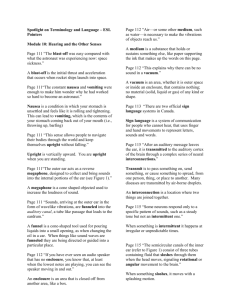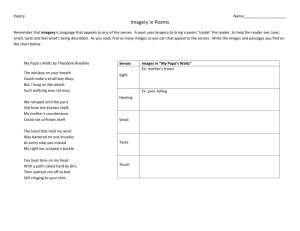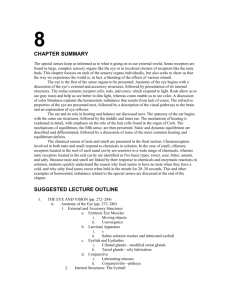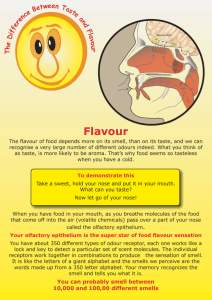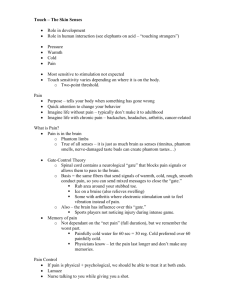it all makes sense
advertisement
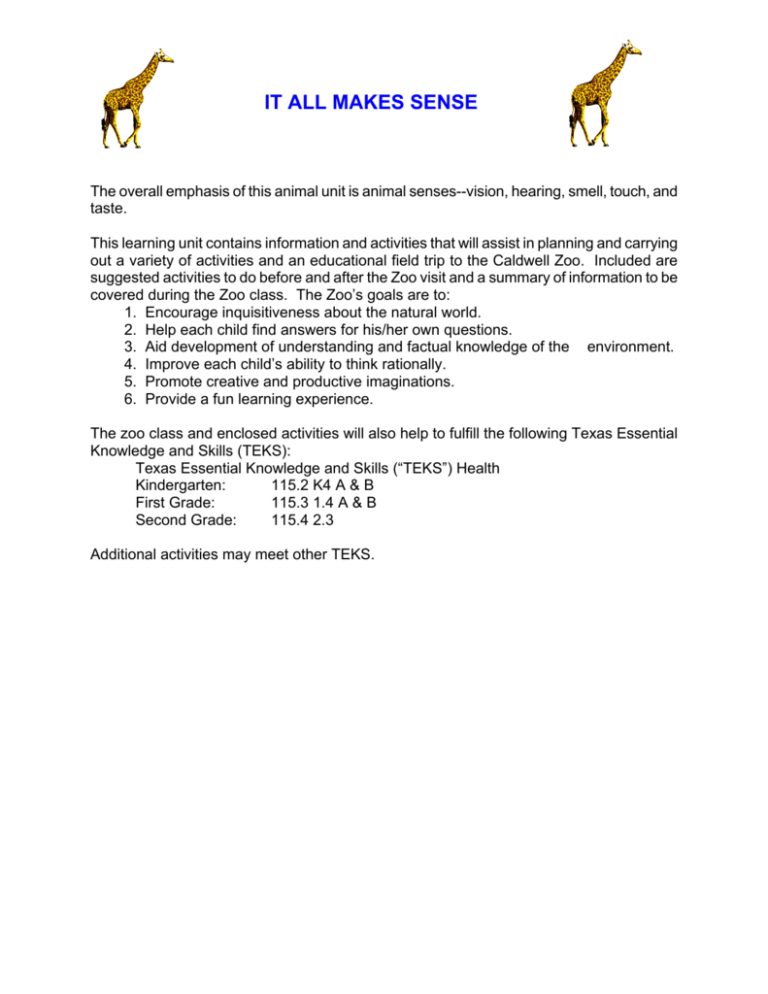
IT ALL MAKES SENSE The overall emphasis of this animal unit is animal senses--vision, hearing, smell, touch, and taste. This learning unit contains information and activities that will assist in planning and carrying out a variety of activities and an educational field trip to the Caldwell Zoo. Included are suggested activities to do before and after the Zoo visit and a summary of information to be covered during the Zoo class. The Zoo’s goals are to: 1. Encourage inquisitiveness about the natural world. 2. Help each child find answers for his/her own questions. 3. Aid development of understanding and factual knowledge of the environment. 4. Improve each child’s ability to think rationally. 5. Promote creative and productive imaginations. 6. Provide a fun learning experience. The zoo class and enclosed activities will also help to fulfill the following Texas Essential Knowledge and Skills (TEKS): Texas Essential Knowledge and Skills (“TEKS”) Health Kindergarten: 115.2 K4 A & B First Grade: 115.3 1.4 A & B Second Grade: 115.4 2.3 Additional activities may meet other TEKS. VISION To have vision means being able to turn light into images of the world around us. Sharpness of vision varies greatly throughout the animal kingdom. As with the other senses, eyesight is most developed in animals that rely on vision for survival. Predators need keen eyesight to detect prey while prey species need it to avoid capture. Sight is the dominant sense in birds and primates since they need to be able to judge distance accurately. Animals living underground, such as moles, do not need sight and have learned to rely on other senses. PERISCOPIC VISION: Eyes are placed on opposite sides of the head and eyes move independently, giving nearly a 360-degree field of vision. (Example: chameleons) BINOCULAR VISION: Ability to form a single image from overlapping fields of vision simultaneously. Allows for depth perception. (Example: birds of prey, primates, and carnivorous mammals, especially cats) STEREOSCOPIC VISION: Vision in which three dimensions of space are clearly perceived and ability to judge depth is present. Eyes are placed so that they not only have binocular vision but also so that the image will fall on corresponding points in the two retinas. (Example: humans and primates, and probably cats possess fairly good stereoscopic vision) NOCTURNAL VISION: No animal can see in total darkness; some light must be available, no matter how little. Most animals that are active at night have larger eyes. In some cases the nocturnal eye is so large that it can no longer move in its socket. (Example: owl) Many animals which are active at night have a special reflective layer behind their retinas to help them maximize the light available. This is what causes eyeshine--the glow seen when a light shines into the eyes of a cat. UNDERWATER VISION: Since light rays bend as they pass through water, it is necessary for certain adaptations to be made to the eye for visual sharpness. Usually aquatic eyes curve differently on the front from those of land animals. COLOR VISION: There is no reliable way to determine which animals can see in color. The ability to see color appears to be based on the species’ need to do so to survive. Most birds and insects can detect a far broader color spectrum than humans. SIMPLE AND COMPOUND EYES: The most primitive eyes are simply photosensitive cells, and like all eyes are a direct opening to the central nervous system. The compound eye is a fixed-focus eye that cannot adjust for near and far vision. A compound eye sends a series of images from each lens making up the total eye (ex. insect eyes) HEARING Ears are used for listening. Ears may or may not have external ear “flaps.” The function of external ear flaps is to catch and funnel sound waves into the animal’s internal ear canals. Some animals with external ear flaps can rotate their ears from front to back in order to better catch sound waves from all directions. Unlike humans, animals with movable ears do not have to move their heads to know which direction a sound is coming from--they just move their ears. The ears of other animals may consist only of holes in the skull which may or may not be covered by a membrane. Some animals have no external ear canal openings at all. Having no external ear canal openings does not mean an animal cannot “hear” (sense sound waves). “Earless” animals can often sense vibrations using other parts of their bodies. (Example: A snake senses vibrations by putting its jaw against the ground.) A few animals have “ear tufts” which have nothing to do with hearing, but are probably a form of display. (Example: Great Horned Owl) SMELL SMELL Animals have many different kinds of noses since all animals have different smelling needs. Olfactory tissue contains nerve cells which detect odors. Usually the longer an animal’s muzzle (nose), the more olfactory nerve endings and thus the better its sense of smell. Animals with short muzzles do not have as much olfactory tissue and consequently their sense of smell is usually not as good as a long muzzled animal. If an odor is faint, an animal may sniff (get more air into the olfactory region) to get a better idea of what the odor is and where it is coming from. Some animals also snort to clear the “old” air from their noses so they can get a better whiff of a new odor. Animals use their sense of smell to: 1. Smell/taste foods 2. Detect predators or prey 3. Find mates 4. Distinguish between family and non-family members 5. Recognize their own territory and territories of other animals TASTE Taste is actually a contact sense. The taste and smell senses are closely related since both are chemical senses. Taste is determined by both humans and animals when a substance comes in contact with taste receptors known as taste buds, although we can only guess how things might taste to animals. Generally mammals have the most taste buds and birds have the fewest. Taste buds are not always on an animal’s tongue. A catfish has taste buds covering its body so it can tell if something swimming by might be good to eat. Insects do not have taste buds but instead have special cells on their bodies that detect tastes and odors. Thus a fly tastes with its feet. Some animals use warning coloration to let predators know that they are not good to eat and perhaps even poisonous. Other animals will mimic the warning coloration in an effort to avoid predation (ex. monarch and viceroy butterflies). TOUCH Touch is the tactile sensations we sense in our environment. In humans our skin is our major tactile organ. Animals may sense touch in a variety of ways. All creatures do have a sense of touch, but how it is used is as varied as the animals themselves. Octopus can use their tentacles to tell the difference between rough and smooth. Animals with antennae or “feelers” use those appendages to extend their reach. Tarantulas have tiny hairs that act as “feelers” to sense their surroundings. Cats have whiskers which give good tactile perception of objects nearby and serve as an invaluable aid at night. Some fish have barbels that are very sensitive to touch as well as scent. Animals often use the sense of touch as a signal. Dolphins use touch as a signal for mating. Spiders sense a vibrating web and know that dinner has just been caught. A baby bird touches the adult’s beak to say, “I’m hungry!” Primates groom/clean each other, using the sense of touch to make individuals feel part of the group. Some animals such as bats and dolphins use “distant touch” when they utilize sonar or echolocation. CLASSROOM ACTIVITIES The activities on the following pages are for use before and/or after the Zoo visit. VISION ACTIVITIES 1. Greet children in a darkened room. Children will begin to understand that we need light to see. 2. Take a walk to observe surroundings. Stop along the way and ask each child to finish the sentence “I see . . . ” 3. Have children cover one eye with a hand or eye patch made from black construction paper and . . . a. Go outside to play a game of catch. Is it harder to catch a ball when seeing out of one eye (limited depth perception)? b. Try various everyday tasks, i.e. eating lunch with one eye covered. c. Divide children into pairs. Have one partner stand in front of the other and move two objects toward and away from the other while he or she tries to decide when both objects are the same distance away. 4. To show how well an eagle can see, get an object about one inch long, put the object on the ground, and start backing away. When the object is no longer visible, measure the distance. Multiply the distance by eight to see how far an eagle is able to see. 5. Place a variety of objects on a table. Ask children to look at the objects for a specified time. Then cover the objects with a cloth and ask children to list what they saw. 6. The iris or colored part of the eye controls the amount of light that enters the eye by changing the size of the pupil. Ask a child to cover his/her eyes. The pupils will get larger, allowing more light to get in. Then have the child remove his hands while a friend observes the change. Or, sit in a brightly lit room with one eye open and one eye closed for 2 minutes. Using a mirror, observe the pupil of the open eye, then open the closed eye and immediately observe the size of the pupil. Record observations with photographs or drawings. How long does it take for both pupils to reach the same size? 7. To help children identify different kinds of vision in animals, set up three learning stations: one with kaleidoscopes, the second with binoculars, and the third with a fish-eye mirror or photos taken with a fish-eye lens. Children visit each station to try out different styles of vision. Ask children what animals they think might have each type of eyesight. (Binoculars--birds of prey, i.e., hawks, eagles, owls) (Kaleidoscopes--insect’s compound eyes) (Fish-eye mirror or photos--fish) 8. Children can write a story entitled, “I Would Like to See Like a _____.” 9. To understand nocturnal vision, create a model of a cat eye using an empty coffee can (inside bottom must be shiny), construction paper, masking tape, and a flashlight. To create the model cat eye, cut a construction paper circle large enough to cover the open end of the coffee can; then cut an oval “pupil” opening in the construction paper circle; and finally, tape the paper to the open end of the can. In a darkened room, hold the cat eye “pupil” end of the can at arm’s length at eye level and look toward the opening in the paper. Now, shine the flashlight toward the opening in the paper. Record observations. Options: Make a series of oval “pupils” of various sizes. Does the size of the pupil relate to the amount of eyeshine? Cover the back of the coffee can with black paper. What happens? 10. Bat and Moth Activity: Ask students to join hands and form a circle. Choose one child to enter the circle and be a bat. That youngster will be blindfolded. Ask 2-3 students to enter the circle as moths. The remaining students continue to join hands and form the boundary of this activity. Explain to students that insectivorous (insect eating) bats use echolocation to find their prey. They emit high-frequency clicks that bounce off objects and are intercepted by bats’ ears. The demonstration “bat” will echolocate by saying the word “bat.” The role-playing “moths” must immediately bounce sound back by saying “moth.” The blindfolded bat must use this auditory clue to locate and tag a moth. Both bat and moth can move around, moths trying to avoid being eaten. The bat may echolocate as often as desired. Moths must immediately respond. Once a moth is tagged, the round is over and others may take a turn. Note: This game can be used as part of vision, hearing or touch activities. If used with hearing, have the “bat” cup his/her hands behind his/her ears to funnel the sound into the ear canal. HEARING ACTIVITIES 1. Help children to feel sound vibrations by placing two fingers lightly on their throats as they say “mmmmmmmmmm.” 2. Fill the children’s area with sounds--sounds of music, a timer set to go off at intervals, etc. Have children sit quietly and listen to everyday sounds. 3. Large external ears help animals collect sound waves and funnel them to their middle and inner ears. Let children design a “super ear” to help humans hear better using construction paper, cardstock, or any other supplies available. After completing the hearing device, children must demonstrate their invention. 4. Some animals locate the source of sound by turning their ears. Blindfold one child. Ask another child to go to the other side of the room and clap. The blindfolded child should try to point out where the sound is coming from by turning his or her head back and forth until the sound is loudest. Take off the blindfold to see if correct. For a more difficult challenge, have children try to follow a moving sound. 5. Animals, especially parents and young, locate each other by sounds. Create sound containers by placing a wide variety of things (popcorn, pennies, nuts and bolts, sand, rice, etc.) in containers such as 35mm film canisters or aluminum soda cans. Make two identical containers for each sound. Give a container to each child. Have each child try to find the child who has the container with the same sound as his or her own container. 6. Secret sounds--Have children try to guess what the secret sound might be. You can use commercially available sound recordings, make tapes of familiar sounds, or have a child step out of sight and make a sound. Be certain the sounds are noises the children will be familiar with. 7. Create a homemade band. The band can be creative and complex or as simple as making kazoos. To make a kazoo, place a small piece of waxed paper on the end of a cardboard tube with a rubber band. Poke a small hole in the tube with a sharp pencil. Have children hum through the kazoo and feel the vibrations with their fingers. SMELLING ACTIVITIES 1. This activity shows how much smelling surface can fit into a dog’s nose. Cut out two squares, one five times bigger than the other. Make three folds in the smaller paper square. This is like the surface area inside a human’s nose. Now fold the larger square 10 times. This is like the surface area inside a dog’s nose. Normally, the larger the surface area of the inner lining of the nose, the better the animal’s sense of smell. Folds in the muzzle’s tissue lining increase the surface area dramatically. 2. Have fun with a Nose Knows activity. Make 10 different scent containers using small containers (35 mm film canisters with small holes poked in the lids work well) and cotton balls. First soak individual cotton balls in different flavorings, extracts or scents (i.e., root beer, chocolate, lemon, orange, vanilla, peppermint, etc.) and put each in a different container. Be certain to use scents that are nontoxic. Number each container so that you will know which scent is in each container. With children seated in a circle, pass one container around. Each child has an opportunity to smell what is in the container, but cannot tell what he or she thinks until everyone has a turn. Conclude the activity with a discussion on the importance of smell. Discuss how humans use their sense of smell and what would happen if an animal failed to recognize a particular odor. 3. Using the scent containers (make sure the containers and lids are numbered so they can be matched) from the Nose Knows activity, the children can participate in the Keeping Track of Baby activity. Divide the group into two teams--one is the mammal mother, the other is the mammal baby. Explain that most mammals identify each other by scent. With the “mothers” at one end of the room and the “babies” at the other end, give a scent container to each “mother.” The “mothers” try to memorize their particular scent then take the lids off and hold onto them. The containers are mixed up and passed out to the “babies” who stand still and hold them out for the “mothers” to sniff. After all the “mothers” find their “babies” check to make sure the number on the lid matches the number on the container. 4. Try the Wintergreen Experiment. Place a few drops of wintergreen extract in a teaspoon. Heat over a candle. Have children raise their hands when they can smell the wintergreen. Record times with stopwatches. Record when the scent is gone. Leave the room and return. Can the wintergreen be smelled any longer? 5. Make a list of the odors noticed throughout a day. Without checking the menu, have children try to guess what is cooking in the cafeteria. While children are out of the room pop some popcorn. Did they know what was happening before they reached the room? Sniffing brings more odors into the olfactory receptors. So go ahead and sniff! TASTE ACTIVITIES 1. Hold a tasting party. Allow children to sample foods that may not be familiar to them--kiwi fruit, various melons, oriental crackers, alfalfa sprouts, etc. Discuss favorite tastes and least favorite tastes, then graph the results. Help children arrange a tasting party with foods of opposite tastes. sweet/honey vs. sour/lemon) (Ex. 2. Be a taste detective. Blindfold children and have them try to detect the flavor of a jelly bean without looking at the color. Have children try to decide the flavor while holding their noses. (Smell is closely associated with taste.) 3. Place equal amounts of salt, flour, cornstarch, and sugar on numbered squares of black construction paper. Do not tell children what substances are on the paper squares. Discuss with children how they could decide which paper contains the salt. Obviously, the easiest way would be to taste each substance and each is edible, but it is dangerous to taste unknown substances. 4. Create a bulletin board of favorite tastes. 5. Take a poll of the children to discover favorite tastes. Is the favorite taste a combination of tastes or a single taste? Graph the results of the taste poll. Discuss the nutritional value of favorite tastes. TOUCH ACTIVITIES 1. Have children bring in swatches of materials with a variety of textures (ex. sand paper, corduroy, satin, etc.). Using samples brought in, blindfold a child and see if he/she can guess what material he/she is touching. Use the swatches of texture to create a bulletin board. Add a list of descriptive words under each texture. 2. Take a touchy tour of the classroom, playground or home. Try the touchy tour with eyes open and/or with a blindfold. Be sure to use lots of adjectives to describe the items touched. 3. Create a “feely” bag or box. Use an opaque bag or box that has an opening just big enough for a child’s hand to fit through to make a “feely” bag or box. Place a familiar object inside (reassure children that all items are safe to touch). Can children correctly name the objects they touch without seeing them? To make this activity a little more challenging, put several objects in large socks and close with a rubber band. Have children remove their shoes and cover their eyes. Can the children figure out what is in each sock by touching with their feet? 4. Obtain a copy of the Braille alphabet (most encyclopedias have the Braille alphabet). Using the alphabet as a reference, allow children the opportunity to create words by gluing dried split peas on strips of construction paper or cardstock. Write the word shown in Braille on the back of the paper strip and challenge others to decode the word. 5. Help children find the difference between an acid and base by using their sense of touch. One property of a base is that it feels slippery and acids do not. (Emphasize that it is unsafe to touch substances unless an adult says that the substance is not harmful.) Fill paper cups with lemon, lime or grapefruit juice, dish detergent, laundry detergent, hand soap, and shampoo. (Detergents, soap, and shampoo may need to be diluted with water.) Ask children to dip their fingers into a cup and tell if the substance is an acid or a base. Be sure children wipe fingers between tests. 6. Experiment with some “sticky” substances. Mix four parts cornstarch and one part water (food coloring may be added to the water) and stir. Give each child some of the mixture in an aluminum pie plate. Allow children time to “play” with the mixture. Discuss the mixture’s properties. Does it feel sticky? When does it feel most sticky? Least sticky? Or, have children feel the consistency of white glue and powdered laundry starch. Which is sticky? Then mix three parts glue to two parts laundry starch and add food coloring if you wish. Stir. Now how does it feel? This substance can be used like Silly Putty brand clay. VOCABULARY WORDS TO KNOW ADAPTATION Modification in structure or function to enhance survival ANTENNAE Sense organs on the head of insects BINOCULAR VISION Both eyes function simultaneously when viewing an object, permitting judgment of distance CONSERVATION Wise use and protection of natural resources including animals and plants ENDANGERED SPECIES A species with numbers reduced to such an extent that it is likely to become extinct in the near future EXTINCT No longer in existence; a species whose members have all died EYESHINE The reflection seen when a light is shined in animal eyes which have a tapetum (a mirror-like layer behind the retina) JACOBSEN’S ORGAN A sensory organ in the mouth of a snake used to identify taste OLFACTORY Related to or concerned with the sense of smell PERIPHERAL VISION Outermost or side vision PUPIL The opening in the eye through which light enters-may be round or vertical PROBOSCIS Elongated snout of various animals, ex. elephant trunk SPECIES A group of animals of the same kind that can mate and produce young like themselves STEREOSCOPIC VISION Three-dimensional sight with depth perception WILD In natural state; not domesticated WILDLIFE Animals which are not ordinarily “tame” or domesticated

